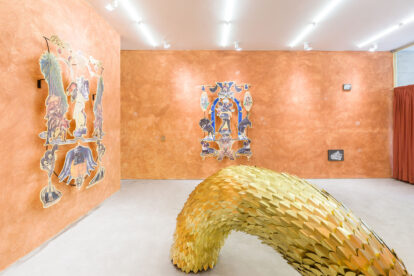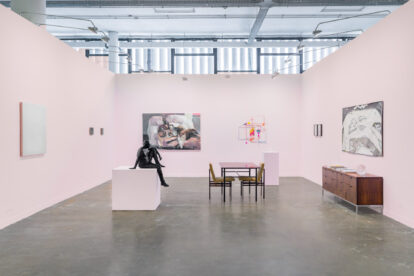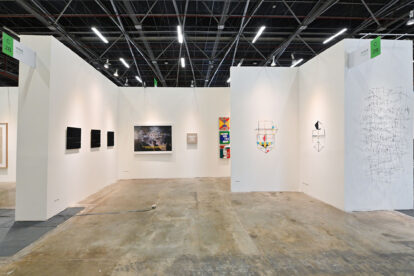A war tank positioned on Copacabana beach is like a float, said anthropologist Jacqueline Muniz in her analysis of the army’s presence on the streets of Rio de Janeiro in 2018, the most recent of occasions when the armed forces were called to protect order in the city since the Brazilian transition to democracy just over three decades ago. For Muniz, federal intervention in the state’s public security was designed to serve political, electoral and media ends, and would not have any real effectiveness in combating organized crime. In its theatrical and confrontational logic, it would thus become representative of Rio’s spectacle police. The war police operations in the city’s slums, and their national and international coverage, symbolically reorder the urban space and reiterate the criminalization of social groups and territories considered dangerous. But if the spectacle of the war on crime visualizes heroes and villains, its legitimacy is contested by perspectives such as those of favela residents repeatedly victimized by its operations, for whom, between stray bullets and extrajudicial executions, the boundaries between police and crime are blurred.
The presence of patrolling tanks in Rio became the starting point for the creation of a series of chimerical sculptures, by Igor Vidor, in the form of species of props. In “Besta-fera (Alegoria do terror series)” [2020], crocodile eyes, eagle wings, dog teeth, goat horns, among others, gain the texture of their aramid fiber support – material used in the manufacture of bulletproof equipment – upon which the printed images are embedded. The work consists of a sculpture of a linear steel structure built in the shape of the combined outline of three shields of São Paulo police forces, bearing images of fragmented bodies of different animals, gathered from the lifting of figures contained in coats of arms of state police forces. Brazilians. Among the shields whose contours are part of its structure is that of the ROTA (Rondas Ostensivas Tobias de Aguiar), a unit created during the military dictatorship to fight the “internal enemy”, which gained fame as the most lethal police in the state. Instead of being undone after the end of the regime, ROTA directed its activities towards common crime, keeping its execution practice shielded by impunity.
The transition from military dictatorships to democratic regimes in Latin American countries, in the 1980s, is marked by the maintenance of authoritarian justice systems, and by the increase in the violation of citizens’ rights by police violence. In Brazil, the maintenance of the military structure of the police in the face of the growth of crime meant an intensification of the repressive practices of the state in a new context shaped by neoliberal capitalism. Against this backdrop, urban violence in the democratic period is the subject of the body of works presented by the artist in his solo show at Künstlerhaus Bethanien, in Berlin. The works in “Allegory of terror” address a complex cycle of violence that, according to anthropologist Teresa Caldeira, is generated by “abuses by the police, the difficulties of police reform, the delegitimization of the judiciary and the privatization of the security… [and constitutes] the main challenge to the consolidation of democracy”. Through the manipulation of symbols, materials and objects, Vidor explores issues such as extrajudicial executions, the arms trade and mass incarceration, establishing a counterpoint to the war on crime narrative.
If the contradictory hybridizations of the spectacle of violence – between democracy and authoritarianism, police and crime, and security and protection – are translated by the artist into chimerical compositions that emphasize their multidimensional monstrosity, such compositional logic extends to the set of works presented, which they complement and resonate with each other in their elaboration of the many faces of the phenomenon of urban violence. Two research documents, of the same measure and shown under red film, are presented juxtaposed and provide a contextual anchor for the works in the encounter between a globalized protection market and police terror. The first consists of a brochure from the Netherlands-based company Teijin Aramid, which presents statistics on vehicle theft and the growth in demand for the car armoring service in São Paulo, for which it develops and supplies materials; the second consists of a negative photograph of a BOPE (Special Operations Battalion) soldier who carries a goat skull, attached to his vest with a carabiner, during an operation on the Mangueira hill, in Rio.
Born in São Paulo, Igor Vidor moved to Rio de Janeiro in 2012, where he has produced, in recent years, an extensive body of work informed by his research on urban violence, gun cultures and social inequality. Working across different mediums such as video, sculpture and installation, his works include objects such as handcrafted toy weapons and projectile capsules, collected in economically dispossessed territories. After the repercussion of his solo exhibition in São Paulo, in 2018, Vidor became the target of death threats by militiamen at a time of political polarization, marked by censorship and persecution of the arts in Brazil, led by the rising right. His move to Germany then took place as self-exile, a few months after the election as president of retired army captain Jair Bolsonaro, whose gesture of simulating firearms with his hands became a campaign symbol. Refractory to human rights and affirmative action policies, and a defender of flexibilization of access to weapons and ammunition, Bolsonaro has made explicit in numerous public appearances during his political career his appreciation for the repressive practices of the military regime and for militia vigilantism, joining them to the current list of world leaders seen as threats to the democracies of their countries.
During the period of his residency in Berlin, Vidor’s research process included visits to the German arms manufacturer Heckler & Koch – whose MP5 submachine gun was used by militiamen to assassinate political and human rights activist Marielle Franco in Rio de Janeiro – and studio experiments with materials used in the production of ballistic equipment and projectiles, such as aramid fiber and lead, which he incorporated into his new works. “Floating Exchange #2” [2020], for example, inscribes the problem of violence in global dynamics. Consisting of a set of patches of national flags with logos of gun manufacturers and silhouettes of firearms printed, sewn and suspended from the ceiling with lead wire, its cuts and junctions alternate between the geometric lines of blocks of color and the contours and silhouettes of logos and weapons, merging their forms into positive and negative spaces, hollowed out. Against the backdrop of arms proliferation in Latin America, the scrambled fragments of flags, including those of Brazil, the US and Germany, reflect the routes established by the global arms trade. Flirting with abstraction, the work transforms its broken symbols into pieces of a power puzzle, echoing the arrangements and dynamics between state and capital.
If the defense of expanding access to weapons and the authorization to kill are based on security rhetoric, research in the area points to their promotion of violence and the weakening of public security. According to anthropologist Luiz Eduardo Soares, the license for extrajudicial execution is at the base of the economy of police brutality in Brazil. From there arise the niches of police officers who become autonomous to kill and sell their lives, and who organize themselves into death squads and militias, expanding their activities from territorial domain to penetration into politics. For Soares, the consolidation of the hegemony of the militias in the country, in the context of the Bolsonaro government, makes police and crime indistinguishable. The ethos of vigilante punitivism permeating violence in the region, then, is captured in a synthetic formulation in “Untitled (Wayne’s Thoughts)” [2020]. The work consists of a fingerprint that reproduces an appropriate speech bubble from a superhero comic book, in which “criminals are a group of superstitious cowards” against whom one must “inflict terror on their hearts”.
Contrary to the rhetoric of protecting the rights of citizens coerced by crime, the choreographies of police raids on favelas bear only signifiers of death, observed researcher Denise Ferreira da Silva. In “Untitled (Gotham remains the same)” [2020] – a twisted black umbrella lying in a corner of the exhibition space – Vidor makes reference to a recent event in the city of Rio de Janeiro, in which a black man was murdered by the police for carrying an umbrella, supposedly mistaken for a rifle. As an object, the umbrella appears earlier in the artist’s work in “Ordinários n.1” [2018], among other objects mistaken for firearms by the police, in events that culminated in the death of their bearers, reflecting the innumerable deaths that do not cease to be produced by the terror of the state. Raciality is central to this dynamic, argues Silva, as it operates as a justification for murder and as a deterrent to the outbreak of an ethical crisis – it is through their logic of differentiation that these bodies and territories always already signify violence. The distinction between those whom state forces should or should not protect, the author points out, implies the suspension of the rights of favela residents in times of conflict between the state and drug trafficking.
In the war on crime, drug policies and a policing model combine to promote mass incarceration, which affects blacks and poor people living in the periphery and slums. As prisons incarcerate bodies of favela residents, and favelas are transformed into prisons, “with helicopters flying overhead, frequent blitzes, collective search warrants, arrests and murders… the division between the two geographical references they [blur]”. Against this backdrop, “Teresa e a Moira” [2020] addresses the issue of agency between a horizon of freedom and the ‘traced destiny’. The sculpture consists of a rope suspended from the ceiling, made of sheets and aramid fiber twisted and tied together, compressed by a lead wire that surrounds it along its entire length, deforming its soft material. The contained tensions of the work are revealed in layers, from the rope improvisation techniques used in prison escapes to the constriction evoked through the figure of Moira, one of the goddesses who in Greek mythology weave and interrupt the thread of life.
For the artist, the use of fabric extends, in its semantic aspect, to the notion of social fabric, since this “establishes a common ground for the use of sheets and aramid, just as social facts are produced in a dynamic common movement of arms and exclusion”. Collected in vulnerable territories in Rio de Janeiro, where they were used to cover bodies of people killed in armed conflicts, they become indices of the systematic violence inflicted on residents of periphery and favelas by state forces. At a time marked by the rise of authoritarian governments and public scrutiny of anti-Black racism and police violence across African diaspora territories, “Allegory of Terror” digs the limits of democracy in the implementation of universal civil and human rights.
By approaching urban violence in Brazil through multiple registers, Igor Vidor’s chimerical compositions inscribe its complexity and interrupt the heroic discourse of the war on crime, bringing to the foreground, as a counterpoint, his war crimes. Combining everyday objects with materials and symbols linked to the state and the global arms industry, the group of works refuses to reproduce images of the spectacle that circulate in the mass media, and its reiteration of the criminalizing gaze on racialized territories and bodies. In doing so, the chimerical compositions explore the incongruity of democratic discourse and police terror, exposing the living legacy of authoritarianism. At the same time, their convergent articulation reveals the ideological continuum that underlies the state of exception in the democratic period, between governments in different positions on the political spectrum, placing, within liberal democracy, the enduring colonial legacy of slavery.

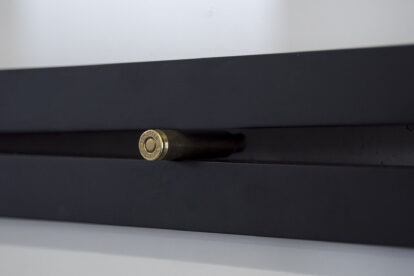
![Esquemas SV17 [Schemes SV17]](https://www.vervegaleria.com/wp-content/uploads/2022/06/ESQUEMAS_SV17-768x647.jpg)
![Esquemas SV18 [Schemes SV18]](https://www.vervegaleria.com/wp-content/uploads/2022/06/ESQUEMAS_SV09-768x663.jpg)
![Se você está vendo isso já é tarde demais (série) [If you're seeing this, it's too late (series)]](https://www.vervegaleria.com/wp-content/uploads/2022/06/se-esta-vendo-1-768x507.jpg)
![Escadinha-lençol [Sheet ladder]](https://www.vervegaleria.com/wp-content/uploads/2022/06/se-esta-vendo-3.png)
![Borda e alegria 1 [Edge and joy 1]](https://www.vervegaleria.com/wp-content/uploads/2022/06/BORDA_01-768x708.jpg)
![Câmbio flutuante #1 [Floating exchange rate #1]](https://www.vervegaleria.com/wp-content/uploads/2022/06/CAMBIO_FLUTUANTE_01B-768x511.jpg)
![Câmbio flutuante #2 [Floating exchange rate #2]](https://www.vervegaleria.com/wp-content/uploads/2022/06/CAMBIO_FLUTUANTE_02-768x512.jpg)
![Batidão M4A1, presente ao Redentor [gift to the Redentor]](https://www.vervegaleria.com/wp-content/uploads/2022/06/BATIDAO_M4_01-768x1150.jpg)
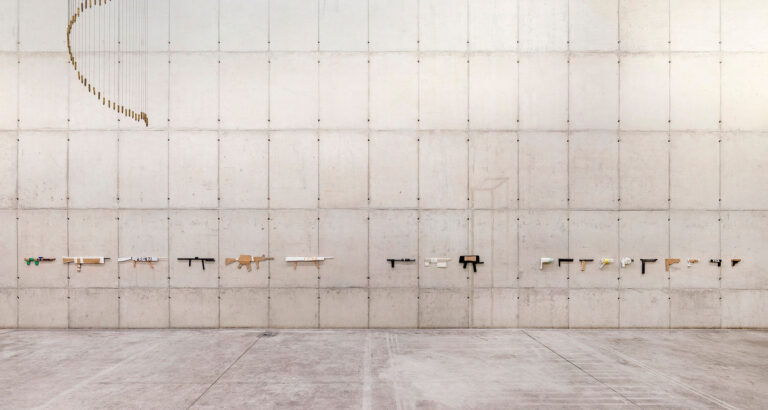
![Sem título (pensamentos do Wayne) e Sem título (Gotham continua a mesma) [Untitled (Wayne's thoughts) and Untitled (Gotham remains the same)]](https://www.vervegaleria.com/wp-content/uploads/2022/06/SEM-TITULO-PENSAMENTOS-DO-WAYNE-E-GOTHAM-CONTINUA-A-MESMA-768x988.png)
![Sem título (A vigia do Wayne) [Untitled (Wayne's watch)]](https://www.vervegaleria.com/wp-content/uploads/2022/06/01-batman-768x549.jpg)
![Viagem pelo Brasil: Spix, Martius e Blanka #1 [Brazil Voyage: Spix, Martius and Blanka #1]](https://www.vervegaleria.com/wp-content/uploads/2022/06/site_01_SPIX-MARTIUS-E-BLANKA_50x33-768x506.jpg)
![A praga (still) [The plague (still)]](https://www.vervegaleria.com/wp-content/uploads/2022/06/a-praga-still-768x432.png)
![A praga [The plague]](https://www.vervegaleria.com/wp-content/uploads/2022/06/teaser_-_a_praga__1080p__Trim_AdobeExpress.gif)
![Sem título (Vitrine) [Untitled (Showcase)]](https://www.vervegaleria.com/wp-content/uploads/2022/06/site_DSC5491-768x512.jpg)
![Sem título (Vitrine) [Untitled (Showcase)]](https://www.vervegaleria.com/wp-content/uploads/2022/06/site_DSC5482-768x512.jpg)
![Sem título (Vitrine) [Untitled (Showcase)]](https://www.vervegaleria.com/wp-content/uploads/2022/06/site_DSC5476-768x512.jpg)
![Besta-fera [Beast-beast]](https://www.vervegaleria.com/wp-content/uploads/2022/06/03-besta-fera06-768x1152.jpg)
![Besta-fera [Beast-beast]](https://www.vervegaleria.com/wp-content/uploads/2022/06/04-besta-fera_edited-768x560.jpg)
![Teresa e a Moira [Teresa and the Moira]](https://www.vervegaleria.com/wp-content/uploads/2022/06/teresa-e-moira-3-768x1016.jpg)
![Consumido, consumado [Consumate-consumed]](https://www.vervegaleria.com/wp-content/uploads/2022/06/CONSUMIDO_CONSUMADO_01B-Copia-768x583.png)
![Consumido, consumado [Consumate-consumed]](https://www.vervegaleria.com/wp-content/uploads/2022/06/CONSUMADO_CONSUMIDO_01-Copia-768x578.png)
![Partida [Departure (or match)]](https://www.vervegaleria.com/wp-content/uploads/2022/06/site_PARTIDA_02-768x1156.jpg)
![Estádio-Estado [Stadium-State]](https://www.vervegaleria.com/wp-content/uploads/2022/06/estadioo-768x510.jpg)
![Estádio-Estado [Stadium-State]](https://www.vervegaleria.com/wp-content/uploads/2022/06/estadio-768x510.jpg)
